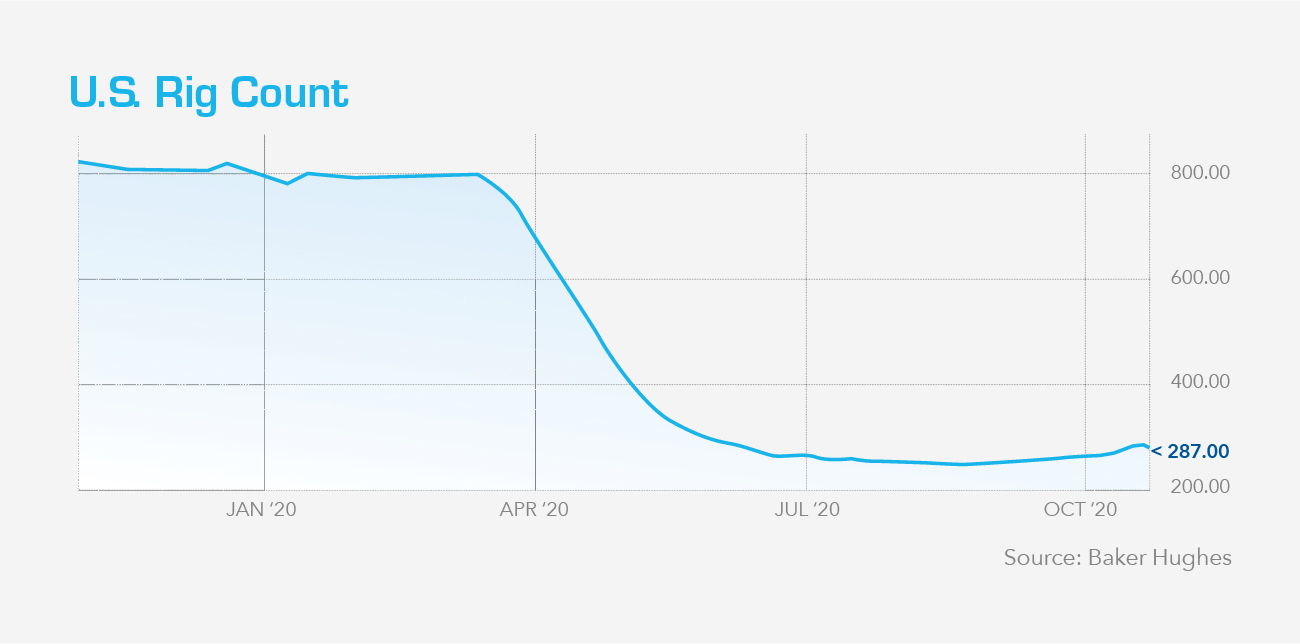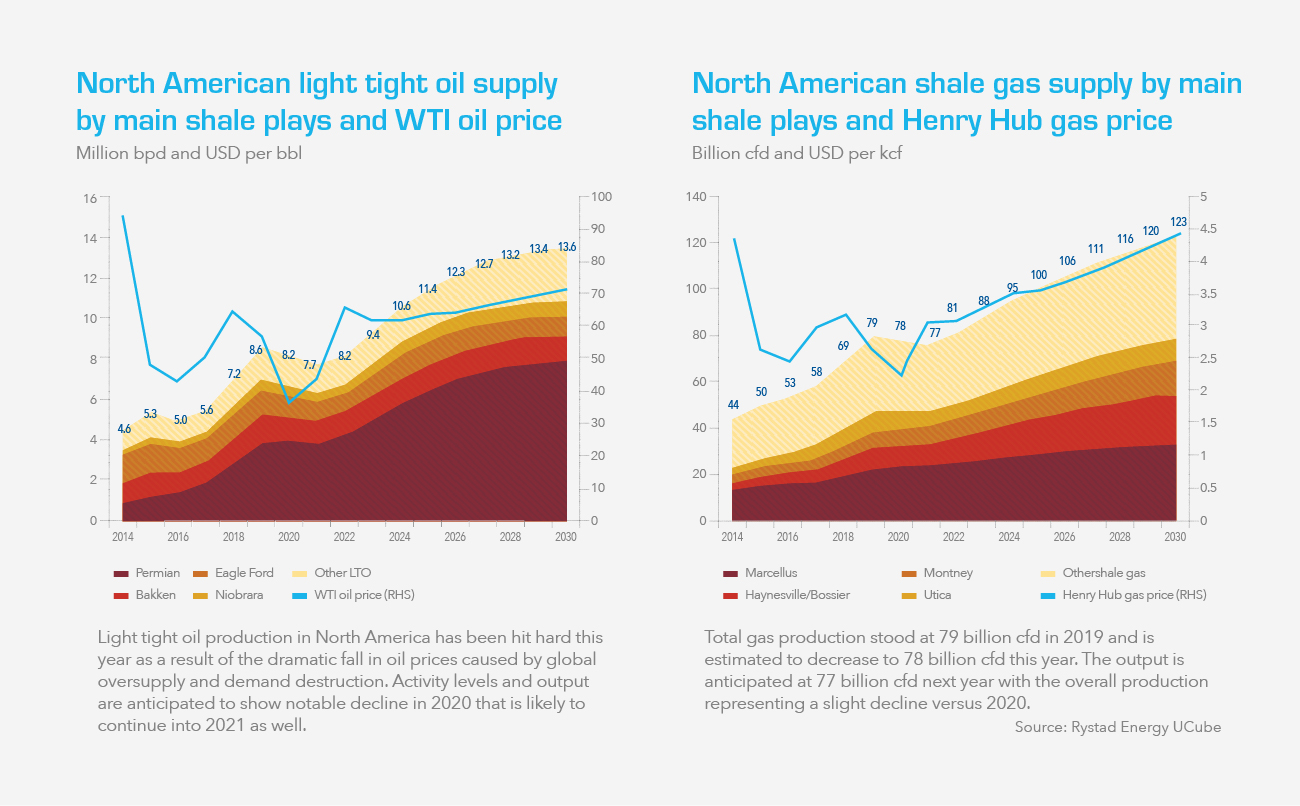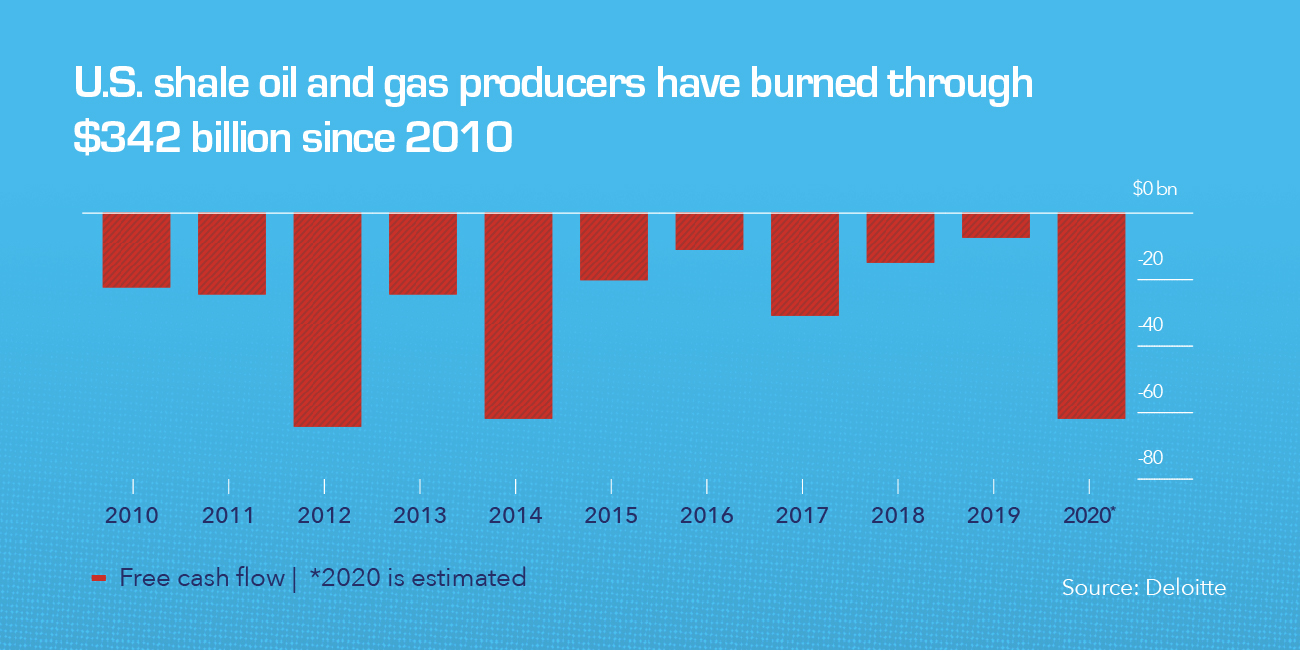The Challenging Landscape Ahead for the Energy Industry and Monetization of its Highly Specialized Assets

In this article we take a look at the current state of the energy industry. We explore the various factors that predisposed it to such a significant downturn in the face of the current crisis, and how the mounting second wave of COVID-19 cases is likely to impact oil producers, industry service providers and the value of their highly specialized assets in the months ahead.
During the course of the initial months of the COVID-19 crisis, fanned by the flames of the then just-escalated Russia/Saudi Arabia oil price war, the oil & gas industry dropped to its lowest historic level on virtually every metric. As demand for oil and gas dropped dramatically, the ripple effects were felt across the industry. At the start of 2020, the number of working drilling rigs in the U.S. stood over 800. By the start of June that count had decreased to 280, and by mid-August had reached a low of 245 working rigs; the lowest on record since Baker Hughes began tracking this information back in 1987. As of October 23, 2020, the rig count stood at 287.
To put the speed of the sea change in the oil and gas market into greater context, we need only to look back to February of 2018, when U.S. crude oil production exceeded that of Saudi Arabia for the first time in over two decades. That same year, the U.S. surpassed Russia in crude oil production for the first time since 1999, doing so in both the months of June and August. By the first half of 2019, however, the oilfield services sector had lost almost 50,000 jobs based on declining demand, pricing and concerns over a trade war with China. Of particular concern, Hydraulic Fracturing (“Fracking”) was facing a catastrophic year after an impressive run, with at least half of all work then underway expected to end by that July.
Fracking extracts natural gas and petroleum from drilled shale rock formations via the use of highly pressurized fluids. The number of U.S.-based fracking wells in the year 2000 stood at 23,000. By 2015, thanks to unprecedented levels of private and public investment in both the industry’s growing number of oil field operators and service providers, this number had risen to approximately 300,000 such wells, accounting for 67% of U.S. natural gas production and 51% of U.S. crude oil production. According to the Energy Information Administration, by 2016 fracking accounted for more than 50% of all oil output, boasting 300,000 fracking wells producing 4.3 million barrels per day. With fracking continuing to transform the oil and gas industry in the U.S., by December 2018, U.S. shale oil production stood at 8 million barrels per day and was expected to reach 9-10 million per day by the early 2020s. As an example of the irrational level of exuberance that surrounded the industry in the period leading up to 2019 – when oil reached $80-$100 per barrel levels – at one point in Odessa, TX, alone, there were over 40 separate operators actively engaged in fracking.

Because of the nature of shale drilling, production from fracking wells can decrease by as much as 70% during their first year of operation. This is a significantly faster depletion rate than is seen with vertical drilling. As a result, “frackers” are continuously engaged in an ongoing process of drilling new wells. This is a highly capital intensive process which has become more and more technologically advanced over the years. As producers and service companies sought to expand their capacity to drill sites and provide equipment, people and services to drive the fracking “engine,” more and more borrowing was necessary and more debt was incurred. Investors, enticed by high demand, escalating oil prices and forecasts of impressive returns continued to eagerly fund this expansion over these “growth” years. But when prices began to soften, the tide shifted. Service companies that had incurred debt to buy more equipment were asked by operators to deliver price concessions and, in turn, requested concessions from the drilling and other contractors that they hired.
While great enthusiasm had existed over U.S. energy independence prior to the pandemic, there was also a rising tide of concern leading into COVID-19 over when the highly indebted companies engaged in these oil and gas producing endeavors would finally become profitable. As the appetite for these investments began to dry up in 2019, fund managers began shifting away from oil and gas equities and private equity began scrutinizing deals at both the production and field service levels through a new, more critical lens. When oil futures dropped to zero soon after COVID-19 arrived the U.S., it became clear to even the holdouts on Wall Street, PE firms and others that the previous level of investment in the industry could no longer be justified.
Working frack spreads in the U.S. used in tight shale O&G began 2020 at a count of 335. When oil prices began their downward cascade in March of 2020, shale producers took dramatic steps to cut back production. By March of 2020, Primary Vision Inc. noted the number of fracking crews deployed to well sites across the U.S. had fallen to the lowest number in more than two years. The fracking fleet departures appeared most pronounced in the Permian, Marcellus and Utica basins. By May, spreads had dropped to only 45. While a modest recovery has occurred since that time, with the current spread count up to around 111, the current outlook from Primary Vision indicates that only 120 spreads may be needed through 2021 based on estimated demand. With the remainder of 2020 not looking much brighter, Baker Hughes Co. has warned investors that explorer spending in North America could drop by an overall rate in the low double digits.
Just prior to the outbreak of COVID-19, in early 2020 the overall U.S. production rate peaked at 13.1 million BBL/day. By August it had shed almost 3.5 million BBL/day. Demand has now increased somewhat, reaching production of 11 million BBL/day in early Oct. Following a similar trajectory, the price of oil began the year at near $60/BBL, but plunged into negative territory at -$36/BBL as a result of futures pricing. Since that time, pricing has rebounded somewhat, fluctuating from the high $30s to low $40’s over the past several months. As of October 28, 2020, natural gas stood at $3.06/MMBtu, its highest recorded spot price since March 2019.
As logic would suggest, companies involved in oil and gas extraction, mining and quarrying are willing and able to invest more significantly in their drilling and related operations when commodity prices are high. This, in turn, drives fee and contract business and subsequent revenues for field service industry operators during such periods. Conversely, when prices decline, producers turn their eye to cost cutting measures, typically restricting drilling activity to those sites most likely to yield the greatest profit and therefore minimizing engagement of oil and gas field services providers.

Across the U.S. in rich oil producing locations such as the Permian Basin (Midland/Odessa Texas and New Mexico), the Bakken Shale (areas of North Dakota), and the Utica and Marcellus Shale (Ohio, Pennsylvania and West Virginia), strong oil and natural gas prices previously made it highly profitable to drill. Now, many producers have shuttered their production or greatly diminished their drilling programs based on a lack of profitability. This, in turn, has impacted much of the equipment previously utilized by service providers in these endeavors. As a result, we are now at the point where multiple service providers, many of whom are under duress, are sitting on largely idled fleets. In some cases, there are literally hundreds of $300,000 to $400,000 trucks going unused that would each typically be commanding a substantial daily or hourly rate to go out and either finish off or frack a well.
Unlike transportation or construction equipment, however, the only intended use for these specialty assets is in the oilfield. As a result, during periods of slow or depressed production in the oil and gas markets, these oilfield drilling & service equipment values are heavily impacted. This is particularly true when, as we see today, an overabundance of such equipment exists in the market alongside very low levels of utilization.
Not only is there now a glut of these very costly, specialized vehicles and other unutilized equipment all across the market, but the majority of typical target buyers for these items are also currently under duress and are not likely looking to replace a 5-year-old truck with a 2-year-old model that is only slightly more efficient. Furthermore, the alternate uses for the vast majority of this equipment are extremely limited, although certain components such as a vehicle’s diesel engine can potentially be sold for use in other applications — as can unused light gear such as flashlights, wrenches and safety vests. It is important to realize, however, that in most cases, these assets are located in geographic areas (North Dakota, other) where most potential buyers are likely in the same industry or have been impacted by the same conditions. With the bottom dropped out for these expensive and specialized assets, and the economics of shipping certain components or gear cross country for sale not truly practical, the discouraging reality is that we are seeing a true buyer’s market that will most benefit those with the resources and wherewithal to see this period through.
Although the pandemic and the pricing pressures that preceded it based on OPEC increasing supply may have been the tipping point, the massive losses incurred by the U.S. oil and gas industry over the past decade clearly set the stage. According to Hayes and Boone’s Oil Patch Bankruptcy Monitor, over the five year period ending September 30, 2020, 248 producers with more than $175 billion in aggregate debt filed for bankruptcy; over $50 billion of that has been in 2020 alone.

For those paying attention, the handwriting was on the wall in the second half of 2019 as justifiably concerned creditors put the handcuffs on exploration spending. This resulted in swift cuts by operators that idled and scrapped fracking equipment, causing industry titans Halliburton, Baker Hughes and Schlumberger to collectively write down close to $25 billion in fracking gear and other assets over the first quarter of 2020 alone.
While oil exploration and production companies are somewhat more insulated via their insurance hedges, they too may soon be compelled to write down their own heavy losses based on continued low oil prices. Furthermore, the recent Devon/WPX merger may be a harbinger of what is to come down the road. While, in the past, buyers in this space have typically paid significant debt-funded premiums to acquire their targets, in this case these two sizable players chose to merge via an all-stock transaction priced at a low single digit premium to WPX’s price at the time. Underscoring where the market is at right now, while an equivalent transaction in the industry three years ago would likely have been valued at somewhere close to $100 billion, the combined value of the Devon/WPX merger was a fraction of that amount at approximately $12 billion.
Among the assets business and their creditors have the potential to market as part of a limited asset monetization event, sale, restructuring or bankruptcy are: mobile energy service equipment/specialty trucks, hard mobile machinery, specialized pumping equipment, generators and gen-sets, pipe, valve, fittings, chemicals, sand, tools, hardware, PPE/safety gear and a host of other items.
Historically, we have seen values for these types of unutilized assets influenced by a number of factors including their condition, support equipment, and the period of time over which they have remained stacked and non-operational. Other variables typically include their geographic location, the time of the year and any associated certifications. In the past, during other periods of industry stagnation, we have observed an expected level of decline in values for older, more obsolete mechanical equipment. Now, however, predicated on the vast amount of idled equipment available with no reasonable prospect of being put to work, and an extraordinarily limited number of interested buyers either domestically or internationally, we are seeing those values significantly diminished. Given this environment, as referenced earlier in this article, companies are taking the unprecedented step of scrapping entire fleets of fracking gear.
This just two years after the industry reached such unprecedented levels of growth that there weren’t even enough skilled workers to fill its ranks.
In scenarios such as this, it is sometimes possible to strategically sell these assets with a specified percentage being marketed through private treaty or consigned to various oilfield auctions over a period of time. The purpose of this approach is to avoid saturating the market, thereby allowing the company to realize maximum asset values. While we have seen this play out with some success under certain conditions, it is Hilco’s opinion that in the current industry and economic climate, these particular approaches to strategic asset marketing may not be able to deliver optimal value during this time.
Conclusions
According to Rystad Energy, Over 100,000 U.S. oil jobs have disappeared since March of 2020. While the largest portion have come from oilfield servicers, significant impact is also now being felt across oil producers and even portfolio managers active in the energy sector. We are now also experiencing a dramatic second wave of COVID-19 infections in this country, which is further extending the impact of social distancing restrictions on the work and personal lives of U.S. residents. With few commuting to work, dining out, attending business conferences, traveling long distances for meetings, vacations or to see extended family… the nation’s airlines, railroads, busses, trucks and cars are largely idled; a troubling reality considering U.S. transportation fuel consumption accounts for over 70% of total U.S. oil consumption, with more than 65% of that amount coming from personal vehicle use.
Given these and the many other factors outlined in the paragraphs above, we do not expect to see a notable recovery in the oil market until Q1 or Q2 2021. Going forward the companies most likely to endure will be those with the strongest balance sheets, most innovative and resilient leadership and, in many cases, the most flexible creditors. Smaller producers and providers with overburdened debt loads will struggle. Some may merge with competitors of a similar size, be acquired, or as we have already seen in many cases, enter bankruptcy.
That said, in the five year term looking out to 2025, demand for oil and gas field services is projected to recover with industry revenue expected to increase at an annualized rate of 4.6% to $107.9 billion. Natural gas and crude oil prices are also expected to increase during the period, allowing for an increased level of investment in the industry, providing what will no doubt be a welcome boost to operators and service providers alike.
In the current environment, Hilco has continued to work closely with both producers and service providers across the industry in a variety of capacities. Most recently, our team was selected by BJ Services, which in July of this year filed for Chapter 11 bankruptcy, to assist in the sale of inventory assets with a book value of $53.6 million. These range from fleet service parts, pumps, fracking chemicals, cements and sand, to engines, transmissions and a wide variety of consumable spares for trucks and operating equipment. If your energy business or companies within your oil and gas portfolio are experiencing distress, regardless of the stage, please consider reaching out to us to explore the potential for implementing a tailored monetization solution that can deliver maximum recovery value for your business assets in this difficult market. Our highly experienced team is here to help.
Hilco Valuation Services is one of the world’s largest inventory appraisers and valuation advisors, serving as a trusted resource to companies, lenders and professional service advisors across virtually every asset category. We have extensive experience in the energy sector, and have conducted a wide range of monetization engagements involving the appraisal, disposition and acquisition of oil and gas industry assets throughout the U.S. and Canada. Hilco Valuation Services has the ability to affirm asset values via proprietary market data gained via its worldwide client experiences. Access to this real-time information, in contrast with the aged data relied upon by others, ensures clients of more reliable valuations, which is crucial when financial and strategic decisions are being made.




